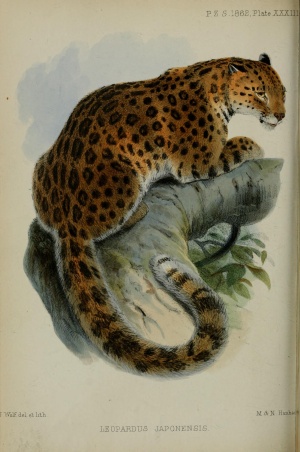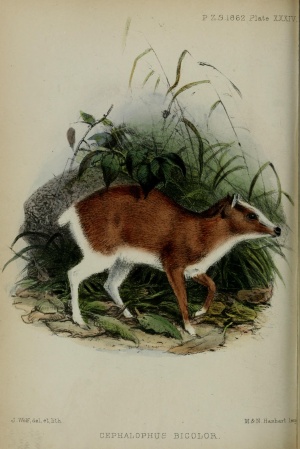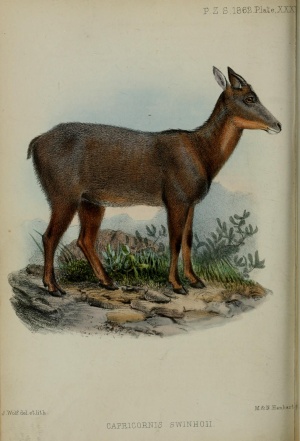2. DESCRIPTION OF SOME NEW SPECIES OF MAMMALIA. BY DR. JOHN EDWARD GRAY, F.R.S., F.L.S., ETC.
(Plates XXXIII., XXXIV., XXXV.)
Among some Mammalia which Mr. A. R. Wallace has lately sent to the British Museum, which he collected in Morty Island in 1861, are two species of a frugivorous Bat, which does not appear to have been hitherto registered in the Catalogue. This Bat may be easily known from all the other Cynopteri by the extraordinary length of
its tail, which induces me to form for it a section or subgenus, which I propose to call Uronycteris.
CYNOPTERUS (URONYCTERIS) ALBIVENTER.
Tail elongate, free, produced beyond the narrow, short, interfemoral membrane. Nostrils much produced, tubular, far apart at the base, and diverging outwardly. Fur brown-olive, with greyer base to the hairs. Face and throat only slightly hairy, grey. Sides of the neck and breast yellow-brown. Side of the body brown. Chest and middle of the belly white. Wings brown.
Hab. Morty Island (A. R. Wallace).
The length of the forearm-bone 2 inches; length of the tail (dry) nearly ¾ of an inch.
The wing-bone, on the upper surface of the wing, of both specimens is marked with some irregular white spots. These may be only accidental, or even artificially produced in the process of preservation or by carriage, as the spots on the two sides of the same wings are more or less unlike, and those of the two specimens are dissimilar.
Mr. Keilish, the furrier, has kindly sent to the British Museum for examination the skin of a Leopard which he has received from Japan. It is well tanned, and marked on the inner side with the red impressions of two Japanese seals. The skin at first sight seemed much like that of a fine-coloured Hunting Leopard, but it is at once distinguished from that animal by the comparatively shorter legs, by the larger size and brown centre of the black spots, and from all the varieties of the Leopard by the linear spots on the nape and the spots on the back not being formed of roses or groups of smaller spots. I propose to call it
LEOPARDUS JAPONENSIS. (Pl. XXXIII.)
Fur fulvous, paler beneath. Back and limbs ornamented with ovate or roundish unequal-sized black spots. The spots on the shoulders, back, and sides converted into a ring by a single central spot of the same colour as the fur. Spots on the back and legs large, oblong, and transverse. Head with small, regularly disposed, black spots. Nape with four series of narrow elongated black spots (the outer ones sometimes confluent into lines), and with a series of large black spots on each side of the back of the neck. Chest with a series of larger spots, forming a kind of necklace. Tail elongate, very hairy, spotted, paler, and with four black rings at the tip.
Hab. Japan.
The skin in its tanned state is 4 feet 6 inches, and the tail 2 feet 10 inches long.
Mr. W. Fosbrooke has kindly presented to the British Museum a small and beautiful species of Boshbock, which was captured by John Dunn, Esq., in the Ungo-zy Forest, between the Umbrelans
and Umblatore, in the country of the Amazula. Mr. Dunn could not learn that the natives had any special name for this animal.
It is a most peculiarly-marked species, and of a very small size. The hunter mistook it for a young animal, and fed it with, milk, on which it died; but when it was examined, the mammaæ, were found dilated with milk, showing that it was approaching full age, and probably had lately produced a faun. It is the smallest species of the genus, standing only 10 inches high to the top of its head, and weighing not more than three pounds. It is most like Cephalophus whitfelclii, figured in the Knowsley Menagerie, from a specimen in the British Museum which was brought from the Gambia by Mr. Whitfield. It differs from that species in the general shade of the brown colour; and there is no white about that animal, which is so prominent in the Natal specimens.
CEPHALOPHUS BICOLOR. (Pl. XXXIV.)
Fur soft, brown, with the rump, the whole of the hind legs, the chin, throat, chest, belly, the inner side of the fore logs, a broad ring over the fore hoofs, and a large spot occupying the front of the face and forehead pure white. The ears blackish, white within. The side of the forehead darker brown. The crumen on the side of the face linear, well marked. Horns not preseut in the female sex.
Hab. Natal.
Mr. R. Swinhoe, having shown me a part of the collection of mammals which he formed while residing in the island of Formosa, has kindly allowed me to describe a new specimen of Wild Goat or Goat-Antelope.
This species agrees in all its characters with the Cambmg-outang (Capricornis swnatrana) of Sumatra, and the Capricornis crispa of Japan, but is very distinct from either of them. In colour it more nearly resembles the Japanese species, C. crispa, which has a white face; but it is easily distinguished from that species, which I only know from a figure and very general description in Schegel's 'Fauna Japonica.' I propose to call it, after its discoverer,
CAPRICORINIS SWINHOII. (Pl. XXXV.)
The fur harsh and crisp, brown, with a narrow streak down the back of the neck; a spot on the knee and the front of the fore legs below the knee black. The hind legs are bay. The sides of the chin pale yellowish. The underside of the neck yellow-bay — this colour being separated from the darker colour of the upper part of the neck by a ridge of longer, more rigid hairs. The ears are long, brown, paler internally. The horns are short and conical. The skull has a deep and wide concavity in front of the orbits, and a keeled ridge on the cheek.


